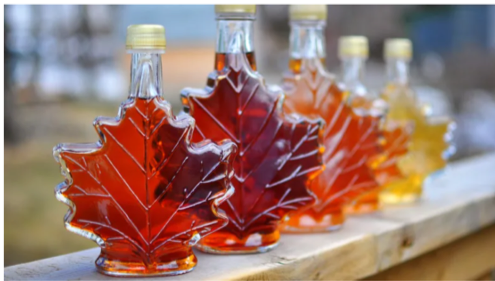The Maple Syrup season is underway
- Deanna Gentner –

The fluctuation of day and night temperatures enables the sap to flow in the xylem of the tree trunk, when the temperature freezes the sap wood contracts creating negative pressure which draws the sap up the tree. When the temperature in the daytime rises the wood expands creating positive pressure enabling the sap to flow. This fluctuation is necessary to keep the sap pumping. The maple tree sap consists of roughly 2% sugar, so producers boil the sap to remove the water and concentrate the sugar with the aim of concentrating the syrup to a minimum of 66% sugar. This process requires on average 40 gallons of sap to make 1 gallon of maple syrup. Depending on the age and size of the tree, a single sugar maple tree can produce between 5 to 15 gallons of sap so to make a single gallon of syrup sap is needed from 2.5 trees.
Maple syrup is graded depending on the color and light transmission of the syrup and the flavor. There are four categories golden, amber, dark and very dark. The darker the color the stronger the maple flavor. There are several factors that determine the color of the syrup this includes the concentration of sugar, pH of the boiling sap, types of sugar in the sap, length of boil time, the outside temperatures, and the microbial activity. If you have seen sap right out of the tree you know that it’s clear in color. When the sap is outside the tree the sucrose molecules are exposed to naturally occurring bacteria and yeast which breaks down the sucrose into more simple forms of sugars: fructose and glucose which go through a Maillard reaction or the “browning” process. The Maillard reaction is what makes French fries golden brown, or browns the crust of baked bread. The lower the temperatures the lower the microbial activity thus the lighter the syrup typically in the beginning of the season. As the season progresses temperatures increase, sugar content in the sap lowers, microbial activity increases resulting in a darker syrup.
New York State is the second largest maple producing state only behind Vermont. In 2019 – 820,000 gallons of maple syrup were produced that marked a 75-year record. New York is home to more than 2,000 maple syrup producers. According to the Executive Director of the New York State Maple Producers Association Helen Thomas “March is the favorite month of NY maple producers. Each day our members wish for favorable weather as they check their maple woods to see how the sap is flowing. The last two weekends in March they open their sugaring operations to the public to demonstrate the process of making maple products from tree to table. Maple producers across New York take great pride producing the finest maple products in the world.” Maple Weekend is a great way to welcome the coming of spring and celebrate nature’s sweetest treat providing a fun and unique experience that the whole family can enjoy. For a listing of maple events near you visit mapleweekend.nysmaple.com.